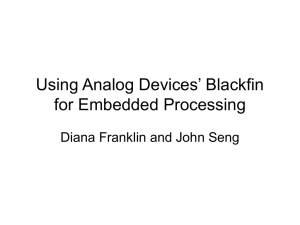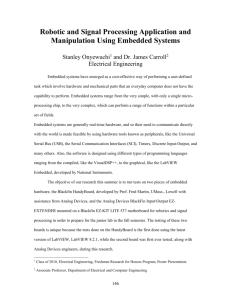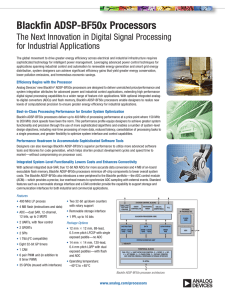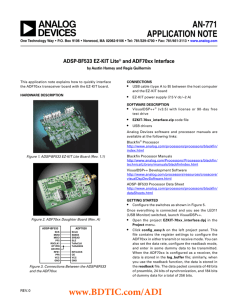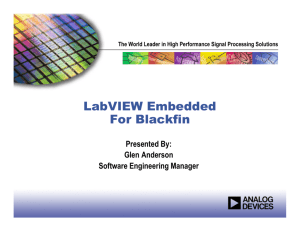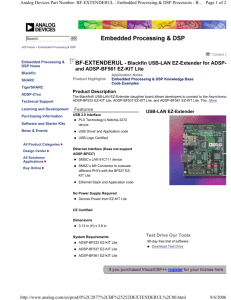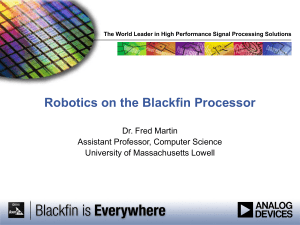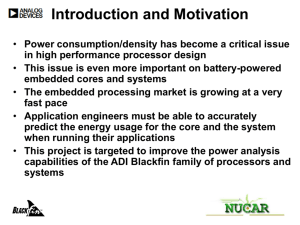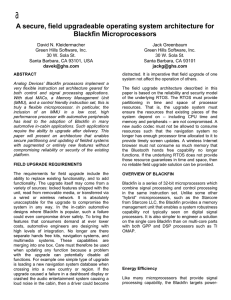Blackfin ADSP-21535 Versus Shark ADSP
advertisement
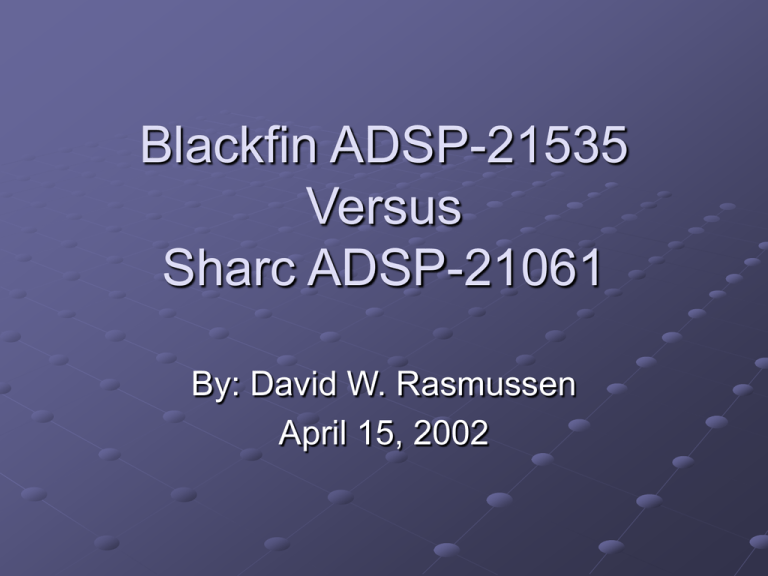
Blackfin ADSP-21535 Versus Sharc ADSP-21061 By: David W. Rasmussen April 15, 2002 To be covered today: Quick overview of the architectures of the both the Blackfin and Sharc DSPs Main features of both processors Main differences between the processors Code sample for an FIR on the Blackfin Benchmark comparison of three major DSP algorithms Sharc ADSP-21061 CACHE JTAG TEST &EMULATION MEMORY 32 x 48 DAG 1 8 x 4 x 32 FLAGS DAG 2 8 x 4 x 24 PMD BUS [1] PROGRAM SEQUENCER PMA BUS 24 DMA BUS 48 32 TIMER PMA DMA PMD BUS CONNECT DMD BUS FLOATING & FIXED-POINT MULTIPLIER, FIXED-POINT ACCUMULATOR 40 DMD REGISTER FILE 16 x 40 32-BIT BARREL SHIFTER FLOATING-POINT & FIXED-POINT ALU [2] Sharc’s Main Features : 32/40-bit IEEE floating-point math 32-bit fixed-point MACs with 64-bit product and 80-bit accumulation No arithmetic pipeline; Thus all computations are single-cycle Circular Buffer Addressing supported in hardware 32 address pointers support 32 circular buffers 16 48-bit Data Registers Sharc’s Main Features Cont.: Six nested levels of zero-overhead looping in hardware Four busses to memory (2 DM + 2 PM) 1 Mbit on-chip Dual Ported SRAM Maximum processing of 50 MIPS Possibility of four parallel operations processed in one clock cycle +/-, *, DM, PM Assuming Pipeline is full PM clashing – utilize Instruction Cache Blackfin ADSP-21535 [3] [4] Blackfin’s Main Features : Two 16-bit MACs, two 40-bit ALUs, and four 8-bit Video ALUs Support for 8/16/32-bit integer and 16/32-bit fractional data types Concurrent fetch of one instruction and two unique data elements Two loop counters that allow for nested zerooverhead looping Two DAG units with circular and bit-reversed addressing 600 MHz core clock performing 600 MMACs Blackfin’s Main Features Cont.: Possibility of the following parallel operations processed in one clock cycle Execution of a single instruction operating on both MACs or ALUs and Execution of two 32-bit Data Moves (either 2 Reads or 1 Read/1 Write) and Execution of two pointer updates and Execution of hardware loop update Main Differences: The Blackfin is only a 16-bit integer processor, however can operate on 32-bit data values. If 32-bit data value used: Either one or two ALU operations can be performed in one clock cycle One MAC can be obtained however will take more than one clock cycle The Sharc is a 32-bit Floating Point processor Main Differences Cont.: The Blackfin has 4 address registers (with corresponding base, length, and modify) to use for circular buffers versus the Sharc’s 32 The Blackfin has 2 nested hardware loops where the Shark has 6 The Blackfin has an 8 stage pipeline (fetch 12, decode, execute 1-3, writeback) where the Shark has a 3 stage The Blackfin is clocked six times faster (300 MHz versus 50 MHz) [5] Blackfin FIR Code Sample : LSETUP(E_FIR_START,E_FIR_END) LC0=P1>>1; //Loop 1 to Ni/2 E_FIR_START: R1=PACK(R1.H,R0.H) || [I0++]=R0 || R2.L=W[I2++]; //Store X1 into the lower half of R1. //Update the delay line. //Fetch h0 into lower half of R2 LSETUP(E_MAC_ST,E_MAC_END)LC1=P2>>1;//Loop 1 to Nc/2 - 1 A1=R2.L*R1.L, A0=R2.H*R1.H || R2.H=W[I2++] || [I3++]=R3; //A1=h0*X1, A0=hn-1*X-n+1. //Fetch h1 into upper half of R2. //Store the output. E_MAC_ST: A1+=R0.L*R2.H,A0+=R0.L*R2.L || R2.L=W[I2++] || R0=[I1--]; //A1+=X0*h1, A0+=X0*h0 //Fetch filter coeff. h2 into the lower //half of R2. Fetch X-1 and X-2 into the //upper and lower half of R0 (for the //first time in this loop) E_MAC_END: A1+=R0.H*R2.L,A0+=R0.H*R2.H || R2.H=W[I2++] ; //A1+=X-1*h2, A0+=X-1*h1 //Fetch h3 into the upper half of R2. //(for the first time in this loop) E_FIR_END: R3.H=(A1+=R0.L*R2.H),R3.L=(A0+=R0.L*R2.L) || R0=[P0++] || R1=[I0]; //A1+=X-n+2*hn-1, A0+=X-n+2*hn+2 //Fetch the next pair of inputs (X2 and X3) into lower //and upper half of R0. Fetch X-n+2 and X-n+3 into R1 ... Benchmarks: For the Sharc [6] Algorithm Type Time Cycles 1024-pt complex FFT FIR Filter (per Tap) 0.37 ms 20 ns 18,221 1 IIR Filter (per Biquad) 80 ns 4 [7] For the Blackfin Algorithm Type Time Cycles 256-pt Complex FFT FIR Filter (per Tap) 0.0106 ms 3,176 13.33 ns 4 IIR Filter (per Biquad) 20 ns 6 Analysis: Blackfin is faster for the three algorithms Unsure of exact performance gain on the FFT (as different lengths) but is somewhere between 2-9 times faster Both the FIR and IIR took more cycles to complete on the Blackfin as more cycles are required for 32-bit operations References 1. 2. 3. 4. 5. 6. 7. ENCM515 Lecture Slides for January 11, 2002, [http://www.enel.ucalgary.ca/People/Smith/2002webs/encm515_02/02presentation s/02january/02overviewSHARCarchitecture.ppt], Dr. Mike Smith Sharc Architecture Overview, [http://www.analog.com/technology/dsp/Sharc/architecture.html], Analog Devices DSP Manuals, [http://www.analog.com/library/dspManuals/pdf/21535/overview.pdf], Analog Devices Blackfin Architecture Overview, [http://www.analog.com/technology/dsp/Blackfin/architecture/basics.html], Analog Devices FIR Blackfin Code Example, [ftp://ftp.analog.com/pub/dsp/blackfin/examples/fir_032101.zip], Analog Devices Sharc DSP Data Sheet, [http://www.analog.com/productSelection/pdf/ADSP20161_L_b.pdf], Analog Devices Blackfin DSP Benchmark Comparison, [http://www.analog.com/technology/dsp/Blackfin/benchmarks/examples.html], Analog Devices Special Thanks To: Mike Roest for the use of his individual assignment – entitled “Examination of the Analog Devices Blackfin and SHARC 21061”, Submitted March 12, 2002 – as preliminary research material for this report.
